These beginner yoga poses to stay calm and de-stress are perfect for easing your body and mind. An added benefit is that they will also provide you with a stable foundation on which you can build a healthy yoga practice for many years to come! By starting with this routine, you will increase strength and improve flexibility, both of which are necessary for a safe and effective yoga practice. If one thing is for sure, it’s that practicing yoga regularly can benefit every aspect of your life: mind, body, and soul!
Yoga for a Healthy Mind
We’re going to forget about the physical benefits of yoga for a moment and focus on how it can help reduce stress, calm anxiety, and promote peace. When you’re performing a yoga routine, you’ll focus on two main things: breathing and stretching. In doing so, you will slow your heart rate and reduce blood pressure.
Yoga also fights the release of cortisol, which is the naturally-occurring stress hormone found in the human body. The less cortisol that is present in your body, the less stressed you will feel. Focusing on taking slow, deep breaths as you relax into each pose, will also help to clear your mind and provide a sense of calm and peacefulness!

10 Best Yoga Poses to Stay Calm and De-Stress
You can easily do this sequence a few times per week and slowly build up to incorporating more difficult moves. For this workout, we just want you to focus on keeping your balance and holding in your core to give your body stability. Jump into our 10 best yoga poses to stay calm and de-stress today and immediately begin reaping the calming benefits!
What you need: A yoga mat or soft surface
What to do: Hold each yoga pose for about 30 seconds. You can hold it for more or less time, depending on what feels comfortable to you. For the high lunge pose, tree pose, Warrior I, and triangle pose, hold the pose for 30 seconds on each side. Cycle through all ten of the poses and then repeat for a total of 2-3 cycles.
We’ve included instructional videos below to help you learn proper form for each pose. Be sure to watch each of them before you begin so that you can get the most out of every pose!
Yoga Flow
-
Cat Cow Pose

Shift some weight to the palms. The wrists, elbows and shoulders are in one line. The abdomen is pulled in and up with the spine arched in a strong Cobra spine. The crown of the head is toward the earth and the neck is relaxed. The gaze is between the arms toward the belly.
Benefits: Relieves the spine and neck. Energizes the body.
-
Downward Facing Dog
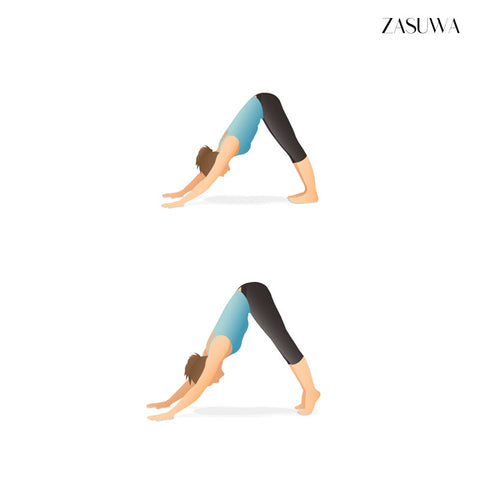
The body is positioned in an inverted "V" with the palms and feet rooted into the earth and sits bones lifted up toward the sky. The arms and legs are straight. The weight of the body is equally distributed between the hands and the feet. The eye of the elbows face forward. The ribcage is lifted and the heart is open. Shoulders are squared to the earth and rotated back, down and inward. The neck is relaxed and the crown of the head is toward the earth. The gaze is down and slightly forward.
Benefits: Calms the brain and helps relieve stress and mild depression. Energizes the body. Stretches the shoulders, hamstrings, calves, arches, and hands. Strengthens the arms and legs. Helps relieve the symptoms of menopause. Relieves menstrual discomfort when done with the head supported. Helps prevent osteoporosis. Improves digestion. Relieves headache, insomnia, back pain, and fatigue. Therapeutic for high blood pressure, asthma, flat feet, sciatica, and sinusitis. Warms up the ankles and the toes.
-
High Lunge
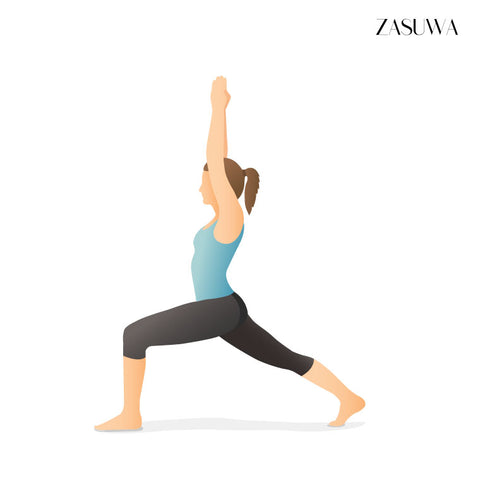
The front foot of one leg is rooted on the earth with the knee directly above and tracking the ankle in a 90-degree angle. The back leg is straight, no bend in the knee, and the weight is distributed backwards onto the toes as the back heel pushes back and down toward the earth. The inner thighs scissor toward each other and the pelvis is tucked under with the ribcage lifted and the chin slightly tucked. The spine is long and extended. The heart is open. The arms are straight with no bend in the elbows or the wrists. The hands can be together or separated and facing each other with the fingers spread wide. Gaze is natural and forward.
Benefits: Creates flexible strength. Promotes stability in the front and back of the torso. Tones the lower body. Stretches the chest, lungs, shoulders, arms, neck, belly, groins (psoas) and the muscles of the back. Strengthens and stretches the thighs, calves and ankles.
-
Cobra Pose

Begin by lying face down with your legs extended behind you, hip-width apart and the tops of your feet rested. Spread your fingers wide and place your hands under your shoulders with your fingers pointing toward the top of the mat. Hug your elbows into the sides of your body. Press down through the tops of your feet and lift your head and chest off the floor. Keep your lower ribs on the floor. Draw your shoulders back and your heart forward keeping your head a natural extension of your spine and your shoulders rolled down and away from your ears. Begin to straighten your arms and lift your chest off the floor. Press the tops of your thighs down firmly into the floor. This is Low Cobra. Little to no weight on your hands. If your flexibility allows, you can straighten your arms all the way while maintaining the connection of the front of your pelvis and legs with the floor.
Benefits: Increases spine flexibility. Stretches the chest and abdominals while strengthening the spine and shoulders.
-
Mountain Pose
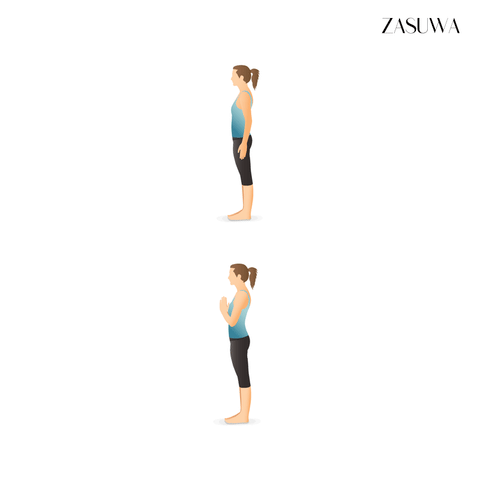
Benefits: Improves posture. Strengthens thighs, knees, and ankles. Firms abdomen and buttocks. Relieves sciatica. Reduces flat feet.
-
Tree Pose

From a standing position, one foot is rooted into the earth with the opposite heel rooted into the inner thigh with the toes pointing toward the earth. The pelvis and the chin are tucked in. The hands come together at the heart in prayer position. The gaze is forward.
Benefits: Strengthens the legs, ankles, and feet. Improves flexibility in the hips and knees. Improves balance.
-
Warrior I
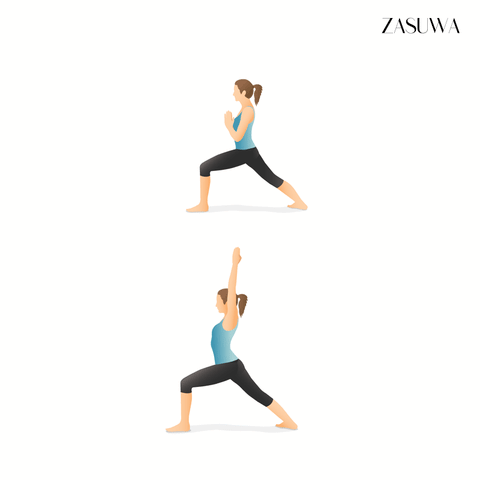
From a standing position, the legs are in a wide stance with the feet aligned and flat on the earth. The back foot is in a 60-degree angle toward the front. The hips are squared. The inner thighs are rotated toward each other. The front knee is bent in a 90-degree angle directly above the ankle. The arms extend up to the sky with the biceps by the ears. The hands can be together or separated and facing each other with the fingers spread wide. The ribcage is lifted and the pelvis tucked. The gaze is forward.
Benefits: Stretches the chest, lungs, shoulders, neck, belly and groin (psoas). Strengthens the shoulders, arms and back muscles. Strengthens and stretches the thighs, calves and ankles.
-
Triangle Pose
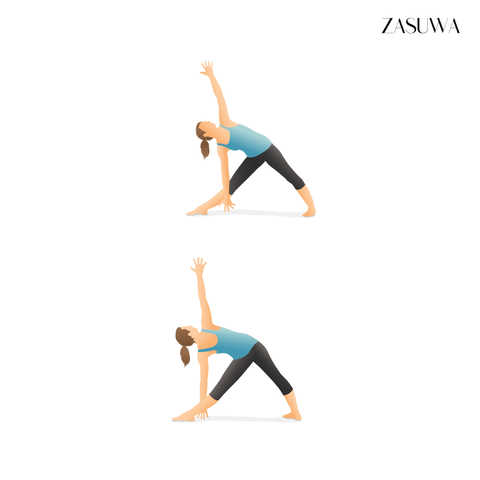
From a standing position, the legs are straight and separated into a wide stance. The feet are aligned and flat on the earth with the back foot in a 60-degree angle toward the front. The inner thighs are rotated externally away from each other. The pelvis is tucked and the ribcage is lifted. One arm extends up toward the sky as the other reaches down to the earth. Both arms are aligned with the shoulders in a straight line. The fingers reach out as the shoulder blades squeeze together. The gaze is toward the front.
Benefits: Stretches and strengthens the thighs, knees, and ankles. Stretches the hips, groin, hamstrings, calves, shoulders, chest, and spine. Stimulates the abdominal organs. Helps relieve stress. Improves digestion. Helps relieve the symptoms of menopause. Relieves backache, especially through second trimester of pregnancy. Therapeutic for anxiety, flat feet, infertility, neck pain, osteoporosis, and sciatica.
-
Bridge Pose
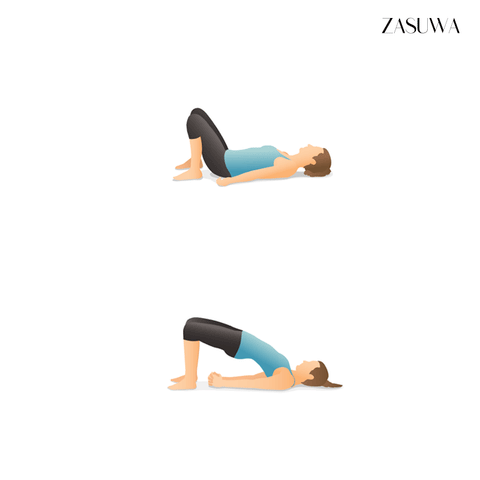
From a supine position, on your back, the hips are pressed up with the heels of the feet rooted into the earth close to the sits bones. The toes are actively lifted and the pelvis tucked. The thighs are parallel to the earth and the fingers are interlaced under the body with the ribcage lifted and the heart open. The back of the neck rests on the earth. The gaze is to the sky.
Benefits: Stretches the chest, neck, and spine. Stimulates abdominal organs, lungs, and thyroids. Rejuvenates tired legs. Improves digestion. Helps relieve the symptoms of menopause. Relieves menstrual discomfort when done supported. Reduces anxiety, fatigue, backache, headache, and insomnia. Therapeutic for asthma, high blood pressure, osteoporosis, and sinusitis.
-
Happy Baby Pose

From a supine position, on your back, the knees are bent slightly wider than the hips. The ankles and shins track the knees in a 90-degree angle perpendicular to the earth. The hands grip the inside sole of the flexed feet (if you have difficultly holding the feet loop a strap over each sole) and push the knees down, coaxing the thighs in toward the torso, lengthening the spine, releasing the tail bone toward the earth and extending the base of the skull away from the back of the neck. The gaze is up toward the sky.
Benefits: Gently stretches the inner groins and the back spine. Calms the brain and helps relieve stress and fatigue.




